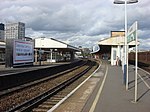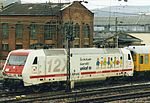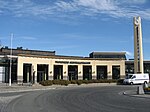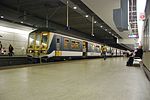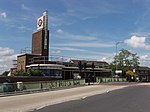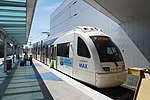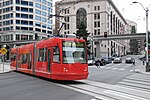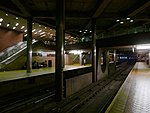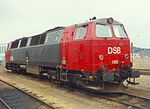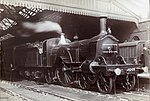Portal:Trains/Selected article/2019 archive
This is an archive of article summaries that have appeared in the Selected article section of Portal:Trains in 2019. For past archives, see the complete archive page.
- Week 1
- January 1 - January 5
The Victoria line is a London Underground line that runs between Brixton in south London and Walthamstow Central in the north-east, via the West End. It is coloured light blue on the Tube map and is one of two lines to run entirely below ground. Constructed in the 1960s, it was the first entirely new Underground line in London for 50 years and was designed to relieve congestion on other lines, particularly the Piccadilly line and the Charing Cross branch of the Northern line. The southern extension to Brixton opened in 1971, and Pimlico station was added in 1972. The Victoria line is a deep-level line and has always been operated using automatic train operation, but all trains carry drivers. There are 16 stations on the route; all but Pimlico provide interchanges with other Underground lines or National Rail services. It is used by 200 million passengers each year and is the most intensively used line on the Underground.
Recently selected: Ski Train - Gants Hill tube station - SeaTac/Airport station
- Week 2
- January 6 - January 12
Vauxhall (/ˈvɒksɔːl/, VOK-sawl) is a National Rail, London Underground and London Buses interchange station in central London. It is at the Vauxhall Cross road junction opposite the southern approach to Vauxhall Bridge over the River Thames in the district of Vauxhall. The mainline station is run by the South Western Railway and is the first stop on the South Western main line from London Waterloo towards Clapham Junction and the south-west. The Underground station is on the Victoria line and the station is close to St George Wharf Pier for river services. The station was opened by the London and South Western Railway in 1848 as "Vauxhall Bridge Station". It was rebuilt in 1856 after a large fire, and given its current name in 1862. In the early 20th century, Vauxhall saw significant use as a stop for trains delivering milk from across the country into London. The tube station opened in 1971 as part of the Victoria line extension towards Brixton, while the bus station opened in 2004. It remains an important local interchange on the London transport network.
Recently selected: Victoria line - Ski Train - Gants Hill tube station
- Week 3
- January 13 - January 19
Waterloo East railway station, also known as London Waterloo East, is a railway station in central London on the line from Charing Cross through London Bridge towards Kent, in the south-east of England. It is to the east of London Waterloo railway station and close to Southwark tube station. The station opened in 1869 as Waterloo Junction, to provide a connection between the London and South Western Railway at Waterloo, and the South Eastern Railway at Charing Cross. A dedicated line was built between Waterloo and Waterloo East, which was later converted to a footpath. Trains originally ran to Cannon Street, but after competition from the London Underground, these were withdrawn as a wartime measure in 1916. The station continued to be connected to Waterloo mainline via a footbridge. Waterloo East was given its current name in 1977, and remains an important interchange in London. It is part of the London station group.
Recently selected: Vauxhall station - Victoria line - Ski Train
- Week 4
- January 20 - January 26
190th Street (originally 190th Street–Overlook Terrace) is a station on the IND Eighth Avenue Line of the New York City Subway, served by the A train at all times. It is located on Fort Washington Avenue near its intersection with Cabrini Boulevard at Margaret Corbin Circle, about three blocks north of 190th Street. The station is close to Fort Tryon Park and the Mother Cabrini Shrine in the Hudson Heights neighborhood of Manhattan's Washington Heights area. The Cloisters medieval art museum, a branch of the Metropolitan Museum of Art, is located in the park, about a 10-minute walk north from the station's Fort Washington Avenue exit. An additional exit through the side of the hill leads to Bennett Avenue and provides access to the Broadway Valley area of Washington Heights.
Recently selected: Waterloo East railway station - Vauxhall station - Victoria line
- Week 5
- January 27 - February 2
128 001, as registered at Deutsche Bahn, or 12X, as named by its manufacturer AEG Schienenfahrzeuge and its successive owners ADtranz and Bombardier Transportation, is an experimental high-performance electric locomotive built in 1994, which was operated as testbed and test locomotive until 2010. The design of the locomotive featured several technological innovations, including power electronics using new types of semiconductors and water cooling, a new final drive concept, a new bogie concept, and protruding windflaps for improved aerodynamics that gave the locomotive a unique look. The development of the locomotive was initiated in anticipation of a major tender for universal locomotives by German railways, but moved towards a modular design when the railways moved towards tendering different types of locomotives for different services. The 12X was the basis of a locomotive class for medium-weight freight trains, the DBAG Class 145, the further development of which ultimately led to Bombardier's TRAXX modular locomotive product platform.
Recently selected: 190th Street (IND Eighth Avenue Line) - Waterloo East railway station - Vauxhall station
- Week 6
- February 3 - February 9
The EMD MRS-1 is a type of diesel-electric road switcher locomotive built by General Motors Electro-Motive Division for the United States Army Transportation Corps (USATC) in 1952. They were built with multigauge trucks and to a narrow loading gauge for service anywhere in the world in the event of war. Thirteen of the locomotives were built, with serial numbers 15873–15885. At almost $500,000 each in 1952 dollars, more than three times the price of a standard locomotive of the period, these were very expensive locomotives. Declared un-needed for wartime operations in about 1970, they were then used on various military bases around the United States, with some serving on the Alaska Railroad. Five locomotives are preserved, three in operating condition.
Recently selected: DBAG Class 128 - 190th Street (IND Eighth Avenue Line) - Waterloo East railway station
- Week 7
- February 10 - February 16
The Highland Branch, also known as the Newton Highlands Branch, was a suburban railway line in Boston, Massachusetts. It was opened by the Boston and Albany Railroad in 1886 to serve the growing community of Newton, Massachusetts. The line was closed in 1958 and sold to the Metropolitan Transit Authority (MTA), which reopened it in 1959 as a light rail line, now known as the D Branch of the Green Line. The first section of what became the Highland Branch was built by the Boston and Worcester Railroad between Boston and Brookline in 1848. The Charles River Branch Railroad, a forerunner of the New York and New England Railroad, extended the line to Newton Upper Falls in 1852. The B&A bought the line in 1883 and extended to Riverside, rejoining its main line there. The MTA electrified the line when it rebuilt it for light rail use. The conversion of the Highland Branch into a light rail line was pioneering in several ways. Amid a backdrop of failing private passenger service in the United States, it was the first time a government entity in that country had assumed full responsibility for losses on a route. It was also the only example of converting an extant commuter rail line to light rail use.
Recently selected: EMD MRS-1 - DBAG Class 128 - 190th Street (IND Eighth Avenue Line)
- Week 8
- February 17 - February 23
Smith–Ninth Streets is a local station on the IND Culver Line of the New York City Subway. It is located over the Gowanus Canal between Smith and Ninth Streets in Gowanus, Brooklyn, and is served by the F and G trains at all times. The station is 87.5 feet (26.7 m) above ground level, making it the highest rapid transit station in the world. This elevated station, opened on October 7, 1933, has four tracks and two side platforms. In 2009, the Metropolitan Transportation Authority began an extensive renovation of the station. It was closed entirely for a full reconstruction between June 2011 and April 2013.
Recently selected: Highland Branch - EMD MRS-1 - DBAG Class 128
- Week 9
- February 24 - March 2
Taiwan High Speed Rail is a high-speed rail line that runs approximately 350 km (217 mi), along the west coast of Taiwan, from the capital Taipei to the southern city of Kaohsiung. At the time it was built, this was one of the world's largest privately funded rail construction schemes. The system is based primarily on Japan's Shinkansen. The line opened for service on January 5, 2007, with trains running at a top speed of 300 km/h (186 mph). Ridership initially fell short of forecasts, but grew from fewer than 40,000 passengers per day in the first few months of operation to over 129,000 passengers per day in June 2013. The system carried its first 100 million passengers by August 2010 and over 200 million passengers had taken the system by December 2012, followed by 400 million by December 2016. In the initial years of operation, THSRC accumulated debt due to high depreciation charges and interest, largely due to the financial structure set up for the private company. The government helped to refinance THSRC's loans to assist the company so it could remain operational and profitable. The government injected NT$30 billion as a financial bailout, boosting the government's stake to about 64% from about 37%, and extended the rail concession from 35 years to 70 years and terminated the company's build-operate-transfer business model.
Recently selected: Smith–Ninth Streets - Highland Branch - EMD MRS-1
- Week 10
- March 3 - March 9
Trondheim Central Station is the main railway station serving the city of Trondheim, Norway. Located at Brattøra in the north part of the city centre, it is the terminus of the Dovre Line and the Nordland Line. The railway is electrified south of the station but not north of it, so through trains must change locomotives at the station. The Norwegian State Railways (NSB) serves the station with express trains to Oslo and Bodø, regional trains to Røros and Östersund in Sweden, and the Trøndelag Commuter Rail. The Trondheim Bus Station located at the station serves all long-distance buses, and some city buses. From 1913 to 1968 the station was also the terminus for two lines of the Trondheim Tramway. Trondheim's first station, dating from 1864, was located at Kalvskinnet. In 1877 the current station was built to serve the Meråker Line to Sweden—since integrated into the Nordland Line. At the same time a connection was built between the two stations, and the central station took over as the main station serving Trondheim. In 1910 construction of a new station for the Dovre Line was started, finishing in 1921. The main station building consists of an older section in historicism brick, while the annex is in postmodernistic concrete and glass.
Recently selected: Taiwan High Speed Rail - Smith–Ninth Streets - Highland Branch
- Week 11
- March 10 - March 16
The Georgetown Car Barn in Washington, D.C., was built between 1895 and 1897 by the Capital Traction Company as a union terminal for several Washington and Virginia streetcar lines. Intended for dual use as a passenger station and as a storage house for the streetcars, the Car Barn began Washington's only cable car system. Almost immediately after the building opened, the system was electrified and the Car Barn was converted to accommodate electric streetcars. Throughout its history as a terminal and storage facility, the Car Barn was never utilized to the extent anticipated by its construction. The building has undergone several renovations, the most extensive in 1911. Not long after its opening, the building fell into disrepair. Changing ownership over time, it maintained its original function of housing streetcars until 1950, when it was redeveloped as office space. Among its occupants was the International Police Academy, an arm of the Central Intelligence Agency, which operated out of the Car Barn in the 1960s and 1970s. Today, it is used as an academic building by Georgetown University.
Recently selected: Trondheim Central Station - Taiwan High Speed Rail - Smith–Ninth Streets
- Week 12
- March 17 - March 23
AirTrain JFK is an 8.1-mile-long (13 km) elevated people mover system and airport rail link serving John F. Kennedy International Airport (JFK Airport) in New York City. The driverless system operates 24/7 and consists of three lines and ten stations. It connects the airport's six terminals with the New York City Subway in Howard Beach, Queens, and with the Long Island Rail Road and subway in Jamaica, Queens. Bombardier Transportation operates AirTrain JFK under contract to the airport's owner, the Port Authority of New York and New Jersey. A railroad link to JFK Airport was first recommended in 1968. In-depth planning for a dedicated transport system at JFK began in 1990, but was ultimately cut back from a direct rail link to an intra-borough people mover. Construction of the current people-mover system began in 1998. The system opened on December 17, 2003, after many delays. The system was originally projected to carry 4 million annual paying passengers and 8.4 million annual inter-terminal passengers every year. The AirTrain has consistently exceeded these projections since opening. In 2017 the system had nearly 7.7 million paying passengers and 12.6 million inter-terminal passengers.
Recently selected: Georgetown Car Barn - Trondheim Central Station - Taiwan High Speed Rail
- Week 13
- March 24 - March 30
The Baltimore railroad strike of 1877 involved several days of work stoppage and violence in Baltimore, Maryland, in 1877. It formed a part of the Great Railroad Strike of 1877, during which widespread civil unrest spread nationwide following the global depression and economic downturns of the mid-1870s. Strikes broke out along the Baltimore and Ohio Railroad (B&O) on July 16, the same day that 10% wage reductions were scheduled. Violence erupted in Baltimore on July 20, with police and soldiers of the Maryland National Guard clashing with crowds of thousands gathered throughout the city. In response, President Hayes ordered federal troops to Baltimore, local officials recruited 500 additional police, and two new national guard regiments were formed. Peace was restored on July 22. Between 10 and 22 were killed, more than 150 were injured, and many more were arrested. Negotiations between strikers and the B&O were unsuccessful, and under the protection of the military and police, traffic resumed on July 29.
Recently selected: AirTrain JFK - Georgetown Car Barn - Trondheim Central Station
- Week 14
- March 31 - April 6
Balboa Park is a Bay Area Rapid Transit (BART) and Muni Metro station complex located south of Balboa Park in southern San Francisco, California. It is an intermodal hub served by four BART routes, three Muni Metro lines, and a number of Muni bus routes. The station complex also includes two rail yards, Cameron Beach Yard and Green Light Rail Center, where Muni maintains Muni Metro trains and heritage streetcars. The San Francisco and San Jose Railroad opened in 1863, with Elkton station located near the modern site. Electric streetcar service at Balboa Park began in 1892 with the San Francisco and San Mateo Electric Railway. The United Railroads conglomerate built its Elkton shops on an adjacent parcel in 1907. The San Francisco portion of BART, including Balboa Park station, opened on November 5, 1973. Muni Metro service to the Balboa Park complex began with the K Ingleside line in 1979, followed by the M Ocean View line in 1980 and the J Church line in 1991. A new BART entrance was completed in 2011, followed by new Muni platforms in 2015 and 2017 and an additional footbridge in 2018.
Recently selected: Baltimore railroad strike of 1877 - AirTrain JFK - Georgetown Car Barn
- Week 15
- April 7 - April 13
The British Rail Class 458 is an electric multiple-unit passenger train built by Alstom at Washwood Heath between 1998 and 2002 for South West Trains. They were the first new fleet of trains to be delivered following the privatisation of British Rail. The fleet of 30 four-car trains was ordered in 1997, with the first train delivered in October 1998. The trains entered passenger service between 2000 and 2003 and are maintained at Wimbledon depot. They form part of Alstom's Juniper family of trains, which also includes Classes 334 and 460. Between 2013 and 2016, they were merged with the mechanically similar Class 460 fleet and reconfigured into 36 five-cars units, designated Class 458/5, to improve capacity. The trains are now used by South Western Railway.
Recently selected: Balboa Park station - Baltimore railroad strike of 1877 - AirTrain JFK
- Week 16
- April 14 - April 20
Cannon Street station, also known as London Cannon Street, is a central London railway terminus and connected London Underground station in the City of London managed by Network Rail. It is one of two London termini of the South Eastern main line, the other being Charing Cross, while the Underground station is on the Circle and District lines. The station runs services by Southeastern, mostly catering for commuters in southeast London and Kent, with occasional services further into the latter. The station was built on a site of the medieval steelyard, the trading base in England of the Hanseatic League. It was built by the South Eastern Railway in order to have a railway terminal in the City and compete with their rivals, the London, Chatham and Dover Railway. The station was initially a stop for continental services from Charing Cross, and that route was convenient for travel between the City and the West End, until the construction of the District Railway. It remained popular with commuters, though its off-peak services were discontinued in the early 20th century, leading to it being closed on Sundays for almost 100 years. As part of the Thameslink Programme development in the 2010s, it was re-opened on Sundays and began to offer more long-distance services in place of Charing Cross.
Recently selected: British Rail Class 458 - Balboa Park station - Baltimore railroad strike of 1877
- Week 17
- April 21 - April 27
City Thameslink is a central London railway station within the City of London, with entrances on Ludgate Hill and Holborn Viaduct. The station is on the Thameslink route between Blackfriars to the south and Farringdon to the north and, with St Pancras, is one of the four core stations on the Thameslink route. The station opened in 1990 to replace Holborn Viaduct railway station. It was part of the Thameslink project that re-opened the Snow Hill Tunnel to provide a continuous north-south route across London. Originally named St. Paul's Thameslink, but to avoid confusion with the nearby St. Paul's tube station on the Central line, it was renamed City Thameslink the following year. The station was refurbished in 2010–11 to increase capacity, and the timetable was revised in 2018 with the introduction of automatic signalling.
Recently selected: Cannon Street station - British Rail Class 458 - Balboa Park station
- Week 18
- April 28 - May 4
Flytoget, the Airport Express Train (Norwegian: Flytoget) is a Norwegian high-speed airport rail link connecting Oslo Airport, Gardermoen to Oslo Central Station in nineteen minutes. Run by Flytoget AS (formerly NSB Gardermobanen AS), it operates on the high-speed Gardermoen Line using sixteen GMB Class 71 electric trains. Normal service frequency is once every ten minutes, with five of the services each hour continuing westwards beyond Oslo Central. The extended services serve nine stops within Greater Oslo and take up to 60 minutes. Flytoget transported 5.4 million passengers in 2007, a 34-percent market share of airport ground transport. The service, which has a top speed of 210 kilometres per hour (130 mph), is the only high-speed rail service in Norway. Construction started in 1994 and high-speed trains began serving Gardermoen Airport from the date of its opening on 8 October 1998, although full operation using the 14.5-kilometre-long (9.0 mi) Romerike Tunnel had to wait another ten and a half months after severe leaks caused by the tunnel's construction led to the partial depletion of two lakes. Formed in 1992 as a subsidiary of Norwegian State Railways, the company has been owned since 2001 by the Norwegian Ministry of Trade and Industry.
Recently selected: City Thameslink railway station - Cannon Street station - British Rail Class 458
- Week 19
- May 5 - May 11
Rogers Locomotive and Machine Works was a 19th-century manufacturer of railroad steam locomotives based in Paterson, New Jersey, in the United States. It built more than six thousand steam locomotives for railroads around the world. Most railroads in 19th-century United States rostered at least one Rogers-built locomotive. The company's most famous product was a locomotive named The General, built in December 1855, which was one of the principals of the Great Locomotive Chase of the American Civil War. The company was founded by Thomas Rogers in an 1832 partnership with Morris Ketchum and Jasper Grosvenor as Rogers, Ketchum and Grosvenor. Rogers remained president until his death in 1856 when his son, Jacob S. Rogers, took the position and reorganized the company as Rogers Locomotive and Machine Works. The younger Rogers led the company until he retired in 1893. Robert S. Hughes then became president and reorganized the company as Rogers Locomotive Company, which he led until his death in 1900. Rogers avoided the American Locomotive Company (ALCO) merger in 1901 through closing and reopening as Rogers Locomotive Works. The company remained independent until 1905, when ALCO purchased it; ALCO continued building new steam locomotives at the Rogers plant until 1913. ALCO used the Rogers facilities through the 1920s as a parts storage facility and warehouse, but eventually sold the property to private investors. Today, several Rogers-built locomotives exist in railroad museums around the world, and the plant's erecting shop is preserved as the Thomas Rogers Building; it is the current location of the Paterson Museum, whose mission is to preserve and display Paterson's industrial history.
Recently selected: Flytoget - City Thameslink railway station - Cannon Street station
- Week 20
- May 12 - May 18
Union Pacific (U.P.) No. 4014, is a four-cylinder articulated 4-8-8-4 Big Boy-class steam locomotive owned and operated by the Union Pacific Railroad. Built in 1941 by American Locomotive Company (ALCO), the locomotive is the only operating Big Boy of the eight that remain in existence. The locomotive operated in revenue service until 1959. It was donated to the Railway and Locomotive Historical Society in late 1961 and thereafter displayed in Fairplex in Pomona, California. In 2013, Union Pacific re-acquired the locomotive and launched a restoration at their Steam Shop in Cheyenne, Wyoming. On May 1, 2019, No. 4014 ran under its own power for the first time in over fifty-nine years, becoming the largest operational steam locomotive in the world. It now operates in excursion service.
Recently selected: Rogers Locomotive and Machine Works - Flytoget - City Thameslink railway station
- Week 21
- May 19 - May 25
The Berlin Stadtbahn ("city railway") is a major railway thoroughfare in the German capital Berlin, which runs through Berlin from east to west. It connects the eastern district of Friedrichshain with Charlottenburg in the west via 11 intermediate stations including Hauptbahnhof. The Berlin Stadtbahn is often also defined as the slightly longer route between Ostkreuz and Westkreuz, although this is not technically correct. The line was originally built in the 1880s. It is 12 kilometers (7.5 mi) in length, and is entirely elevated above the city's streets. The four-track route carries S-Bahn, Regionalbahn, Regional-Express, Intercity, EuroCity and Intercity-Express trains.
Recently selected: Union Pacific 4014 - Rogers Locomotive and Machine Works - Flytoget
- Week 22
- May 26 - June 1
Boston Manor is a London Underground station in the London Borough of Hounslow. The station is situated on the Heathrow branch of the Piccadilly line, between Osterley and Northfields stations, in Travelcard Zone 4. The station is on a street-level bridge over the line on Boston Manor Road, serving the suburban Boston Manor neighbourhood. Opened in 1883 by the District Railway, it was reconstructed in 1932 to a Grade II-listed building. Designed by architect Charles Holden, the Art Deco styled structure features a tall tower which acts as a landmark of the area. The station was once served by both the Piccadilly and District lines, with the latter having its last service withdrawn in 1964.
Recently selected: Berlin Stadtbahn - Union Pacific 4014 - Rogers Locomotive and Machine Works
- Week 23
- June 2 - June 8
The BMT Fourth Avenue Line is a rapid transit line of the New York City Subway, mainly running under Fourth Avenue in Brooklyn. The line was originally built by the Brooklyn Rapid Transit Company (BRT; later Brooklyn–Manhattan Transit Corporation, or BMT) and is now internally operated as part of the New York City Subway's B Division. Fourth Avenue never had a streetcar line or elevated railway due to the provisions of the assessment charged to neighboring property owners when the street was widened. Construction of the line was only undertaken because of the efforts of the local communities. After the line was opened, development resulting from the line's construction transformed communities such as Dyker Heights, Fort Hamilton and Bay Ridge. One station, Myrtle Avenue, was abandoned in 1956 as part of the reconfiguration of the busy DeKalb Avenue Junction.
Recently selected: Boston Manor tube station - Berlin Stadtbahn - Union Pacific 4014
- Week 24
- June 9 - June 15
The Standard class 6, otherwise known as the Clan Class, was a class of 4-6-2 Pacific tender steam locomotive designed by Robert Riddles for use by British Railways. Ten locomotives were constructed between 1951 and 1952. The Clan Class was based upon the Britannia Class design, incorporating a smaller boiler and various weight-saving measures to increase the route availability of a Pacific-type locomotive for its intended area of operations, the west of Scotland. The Clan Class received a mixed reception from crews, with those regularly operating the locomotives giving favourable reports as regards performance. However, trials in other areas of the British Railways network returned negative feedback, a common complaint being that difficulty in steaming the locomotive made it hard to adhere to timetables. The class was ultimately deemed a failure by British Railways, and the last was withdrawn in 1966. None survived into preservation, although a project to build the next locomotive in line, number 72010 Hengist, is progressing.
Recently selected: BMT Fourth Avenue Line - Boston Manor tube station - Berlin Stadtbahn
- Week 25
- June 16 - June 22
Far Rockaway–Mott Avenue (announced simply as Far Rockaway) is the eastern terminal station on the New York City Subway's IND Rockaway Line. Originally a Long Island Rail Road station, it is currently the easternmost station on the New York City Subway. It is served by the A train at all times. As of 2016, this station is the busiest of all subway stations in the Rockaway peninsula. The original surface station on this site was opened in 1869; the current elevated station began operation as a subway station on January 16, 1958. The station was renovated in 2009–2012 at a cost of $117 million.
Recently selected: BR Standard Class 6 - BMT Fourth Avenue Line - Boston Manor tube station
- Week 26
- June 23 - July 29
Kilburn is a London Underground station at Brondesbury Park in north-west London. It is on the Jubilee line, between Willesden Green and West Hampstead stations. The station is on the A5 Kilburn High Road or Shoot-up Hill, approximately 0.1 miles (0.16 km) north of Brondesbury station. The station was first opened on the Metropolitan line in 1879 as part of an extension to Willesden Green. The two-track line through the station was quadrupled in the 1910s. After merging to form the London Passenger Transport Board in 1933, Metropolitan line services through the station were transferred to the Stanmore branch of the Bakerloo line, and was extensively rebuilt. This branch was then transferred again to the Jubilee line in 1979. The 1930s station building remains, and was refurbished in 2005. The station is now wheelchair accessible and has frequent train services to Central London.
Recently selected: Far Rockaway–Mott Avenue (IND Rockaway Line) - BR Standard Class 6 - BMT Fourth Avenue Line
- Week 27
- June 30 - July 6
Moorgate is a central London railway terminus and connected London Underground station on Moorgate in the City of London. Main line railway services for Hertford, Welwyn Garden City and Letchworth are operated by Great Northern, while the Underground station is served by the Circle, Hammersmith & City, Metropolitan and Northern lines. The station was opened as Moorgate Street in 1865 by the Metropolitan Railway. In 1900, the City & South London Railway added the station to its network, and the Great Northern & City Railway began serving the station in 1904. In 1975, the Northern City Line platforms were the site of the Moorgate tube crash – at the time, the worst peacetime accident in the history of the London Underground – in which 43 people were killed. Thameslink branch services were withdrawn in the early 21st century, and Crossrail improvements will see Moorgate connected to Liverpool Street.
Recently selected: Kilburn tube station - Far Rockaway–Mott Avenue (IND Rockaway Line) - BR Standard Class 6
- Week 28
- July 7 - July 13
The North South Line (NS Line) is a streetcar service in Portland, Oregon, United States, that is part of the Portland Streetcar system. Operated by Portland Streetcar, Inc. and TriMet, it travels approximately 4 miles (6.4 km) per direction serving 39 stations. It runs every day of the week between 15 and 18 hours per day, operating on headways of 15 to 20 minutes. The NS Line is the busiest of Portland's three streetcar routes; it carried an average of 8,751 weekday riders in September 2018. The restoration of streetcar service, which last operated in Portland in 1950, began with the efforts of a citizen advisory committee in 1990. After nearly a decade of planning, construction began in 1999. With the opening of its first 2.4-mile (3.9 km) segment in 2001, it became the inaugural line of the Portland Streetcar system, as well as the first second-generation streetcar service in the United States, owing to its use of modern vehicles. Having previously had no distinct route name, it was designated the North South Line in September 2012, with the opening of the system's second service, the Central Loop Line, which was later renamed Loop Service.
Recently selected: Moorgate station - Kilburn tube station - Far Rockaway–Mott Avenue (IND Rockaway Line)
- Week 29
- July 14 - July 20
Portland International Airport is a light rail station in Portland, Oregon, United States, that is served by TriMet's MAX Light Rail system. It is the eastern terminus of the Red Line, which connects travelers to Portland City Center and Beaverton. The station consists of one island platform with both tracks joining just beyond, as the section approaching the terminal is single-tracked. It recorded an average of 2,461 weekday boardings in fall 2018. The station was built as part of the Airport MAX project, which extended light rail service to the airport with the construction of a four-station, 5.5-mile (8.9 km) branch line off of the Eastside MAX segment near Gateway/Northeast 99th Avenue Transit Center. Construction of the station began in July 2000 and it opened on September 10, 2001.
Recently selected: NS Line - Moorgate station - Kilburn tube station
- Week 30
- July 21 - July 27
The R Broadway Local is a rapid transit service in the B Division of the New York City Subway. Its route emblem, or "bullet", is colored yellow since it uses the BMT Broadway Line in Manhattan. The R was originally the Brooklyn–Manhattan Transit Corporation's 2 service, running along the BMT Fourth Avenue Line in Brooklyn then traveling through the Montague Street Tunnel to Manhattan, then running local on the BMT Broadway Line. The 2 became the R in 1961. The R ran local along the BMT Astoria Line in Queens, terminating at Astoria–Ditmars Boulevard until it switched terminals with the N in 1987. After 1987, the R ran via the IND Queens Boulevard Line to Forest Hills, Queens. A variant of the R, from Bay Ridge to Lower Manhattan via the BMT Nassau Street Line, ran from 1967 until 1987.
Recently selected: Portland International Airport station - NS Line - Moorgate station
- Week 31
- July 28 - August 3
Rail transport in New Zealand is an integral part of New Zealand's transport network, with a nationwide network of 4,128 kilometres (2,565 mi) of track. It has a particular focus on bulk freight exports and imports, with 18 million net tonnes moved by rail annually. Starting with the Ferrymead Railway in 1863, most public railway lines were short, built by provincial governments and connected major centres to their nearest seaport. However, from the 1870s, focus shifted to building a nationwide network linking major centres. A narrow gauge of 3 ft 6 in (1,067 mm) was adopted nationally. Railways became centrally controlled as a government department under the names New Zealand Government Railways or New Zealand Railways Department (NZR). In the early 1980s, NZR was corporatised as the New Zealand Railways Corporation and drastically restructured, becoming a state-owned enterprise in 1987. In 1991, the rail, inter-island ferry and infrastructure businesses of the Railways Corporation were split off into New Zealand Rail Limited, which was privatised in 1993, and renamed Tranz Rail in 1995. The central government renationalised first the Auckland metro railway network in 2001, then the rest of the country in 2004, and finally the rail and ferry operations in 2008, creating a new state-owned enterprise, KiwiRail. Today, services are primarily focused on bulk freight, with a small number of tourist orientated passenger services. Urban passenger rail services exist only in Auckland and Wellington. Rail in New Zealand has received significant and ongoing government investment since re-nationalisation in 2008, with the two urban rail systems being upgraded.
Recently selected: R (New York City Subway service) - Portland International Airport station - NS Line
- Week 32
- August 4 - August 10
The South Lake Union Line is a streetcar route in Seattle, Washington, United States, forming part of the Seattle Streetcar system. It travels 1.3 miles (2.1 km) and connects Downtown Seattle to the South Lake Union neighborhood. The South Lake Union Streetcar was the first modern line to operate in Seattle, beginning service on December 12, 2007. The streetcar line was conceived as part of the redevelopment of South Lake Union into a technology hub, with support from Paul Allen and his venture capital firm Vulcan Inc. Construction began in July 2006 and was completed in December 2007 by the Seattle Department of Transportation. The line is popularly known by its nickname, the South Lake Union Trolley (abbreviated as "SLUT"), which is used on unofficial merchandise sold by local businesses. The streetcar was controversial in its first few years due to its slow speed, low ridership, public funding, and connections to real estate development. Improvements to the streetcar's corridor since 2011 have increased service and improved schedule reliability, but ridership has declined since peaking in 2014. A planned streetcar project to connect the South Lake Union Line with the First Hill Line via Downtown Seattle was placed on hold by the city government in 2018.
Recently selected: rail transport in New Zealand - R (New York City Subway service) - Portland International Airport station
- Week 33
- August 11 - August 17
U District (working name Brooklyn) is a future light rail station located in Seattle, Washington. It is situated in the University District neighborhood, near the University of Washington campus, and is being built as part of the Northgate extension of the Link light rail system. The underground station will have two entrances along Brooklyn Avenue NE at NE 43rd and 45th streets. Construction on the Northgate extension was approved by voters in a 2008 ballot measure and began in 2012. The station is scheduled to be completed in 2021, along with the rest of the Northgate extension. Sound Transit estimates that there will be 12,000 daily boardings at the station in 2030.
Recently selected: South Lake Union Streetcar - rail transport in New Zealand - R (New York City Subway service)
- Week 34
- August 18 - August 24
Westlake is a light rail station that is part of the Downtown Seattle Transit Tunnel in Seattle, Washington, United States. It is served by the Central Link, part of Sound Transit's Link light rail system, and also connected above ground by buses at several stops, the South Lake Union Streetcar, and the Seattle Center Monorail. Westlake station consists of two underground side platforms, connected to the surface by entrances and a mezzanine level served by nearby department stores. The transit tunnel was built in the 1980s by King County Metro and opened for bus-only service on September 15, 1990. The tunnel was closed from 2005 to 2007 for a major renovation to prepare for light rail service, which began on July 18, 2009. Link light rail trains terminated at Westlake until the opening of the University Link Extension on March 19, 2016; the tunnel became train-only in March 2019. Trains serve the station twenty hours a day on most days; the headway between light rail trains is six minutes during peak periods, with less frequent service at other times. A second downtown tunnel is planned to be built in 2030, with a transfer at Westlake station for traffic continuing towards South Lake Union and Ballard.
Recently selected: U District station - South Lake Union Streetcar - rail transport in New Zealand
- Week 35
- August 25 - August 31
WTC Cortlandt, additionally signed as World Trade Center on walls and formerly known as Cortlandt Street and Cortlandt Street–World Trade Center, is a station on the IRT Broadway–Seventh Avenue Line of the New York City Subway in Lower Manhattan. The station is located under the intersection of Greenwich Street and Cortlandt Way within the World Trade Center. The original Cortlandt Street station was built by the Interborough Rapid Transit Company (IRT) and opened in 1918. The station was renovated in the 1960s when the original World Trade Center was built. The Cortlandt Street station was destroyed on September 11, 2001. Although service on the Broadway–Seventh Avenue Line was restored in 2002, the station's reconstruction was delayed until 2015 because the Port Authority of New York and New Jersey had to first rebuild the World Trade Center PATH station beneath it. After an extensive reconstruction, the Cortlandt Street station reopened on September 8, 2018, as WTC Cortlandt.
Recently selected: Westlake station (Sound Transit) - U District station - South Lake Union Streetcar
- Week 36
- September 1 - September 7
Becontree is a London Underground station on Gale Street in the Becontree neighbourhood of the London Borough of Barking and Dagenham in northeast London, England. The station is on the District line, between Upney and Dagenham Heathway stations and is in Travelcard Zone 5. The station was originally opened as Gale Street Halt in 1926 by the London, Midland and Scottish Railway on the existing route from Fenchurch Street to Southend. The station was renamed and completely rebuilt in 1932 with an additional pair of platforms to serve the electric District Railway (now the District line) local service. National rail services ceased to call at the station since the 1960s, leaving only two platforms in operation.
Recently selected: WTC Cortlandt station - Westlake station (Sound Transit) - U District station
- Week 37
- September 8 - September 14
Bellows Falls station is an Amtrak intercity rail station in located in the Bellows Falls village of Rockingham, Vermont, United States. The station is served by the single daily round trip of the Washington, D.C.–St. Albans Vermonter. It has a single side platform adjacent to the single track of the New England Central Railroad (ex-Central Vermont) mainline. Three railroads were completed to Bellows Falls in 1849, followed by the Vermont Valley Railroad in 1851. This placed Bellows Falls at the junction of two major trunk lines. A two-story brick station was constructed in 1851 at the junction of the four railroads. After a number of mergers and leases over the next half-century, service was consolidated into three major railroads by 1900. The Boston and Maine Railroad (B&M) and Central Vermont (CV) ran north-south service through Bellows Falls, while the B&M and Rutland Railroad collaborated on east-west traffic on the Boston–Montreal route via Bellows Falls. Much of the downtown area, including the train station, was destroyed in a 1921 fire; it was replaced in 1922–23 with a one-story brick building on the same site. Passenger service declined over the following decades, with all passenger service to Bellows Falls ending in 1966. In 1972, newly-created Amtrak restored the Washington, D.C.–Montreal Montrealer. Bellows Falls was served by the Montrealer from 1972 to 1987, and 1989 to 1995; since 1995 it has been served by the Vermonter. The station building and a circa-1880 Railway Express Agency (REA) building nearby were added to the National Register of Historic Places in 1982 as part of the Bellows Falls Downtown Historic District. The former REA building houses the offices of the Green Mountain Railroad.
Recently selected: Becontree tube station - WTC Cortlandt station - Westlake station (Sound Transit)
- Week 38
- September 15 - September 21
Bergen Street is a station on the IND Culver Line of the New York City Subway, located at the intersection of Bergen Street and Smith Street on the border of Cobble Hill and Boerum Hill in Brooklyn. It is served by the F and G trains at all times. The Bergen Street station was constructed by the Independent Subway System (IND). It opened in March 20, 1933 as the original terminus of the Smith Street Line. The station opened in advance of the opening of the remainder of the line to allow for it to compete with existing streetcar lines belonging to the Brooklyn–Manhattan Transit Corporation (BMT). Bergen Street was renovated in the 1990s. Bergen Street was constructed as a bi-level express station, though only the upper level is in use. In 2019, express service returned to the line, though express trains skipped the Bergen Street station due to the high cost of rebuilding its express platforms on the lower level.
Recently selected: Bellows Falls station - Becontree tube station - WTC Cortlandt station
- Week 39
- September 22 - September 28
Brooklyn Manor was a station on the Long Island Rail Road's Rockaway Beach Branch located on the south side of Jamaica Avenue at 100th Street, straddling the border between Richmond Hill and Woodhaven in Queens, New York City. The station name referred to the nearby Brooklyn Manor section of Woodhaven, originally a 603-lot development bounded by Woodhaven Boulevard to the west, 96th/98th Streets to the east, Forest Park to the north, and Jamaica Avenue to the south. The station opened in January 1911, and was constructed as a replacement for the Brooklyn Hills station, which was located 3,000 feet (910 m) to the north. This station closed along with the rest of the Rockaway Beach Branch in 1962, and was subsequently demolished.
Recently selected: Bergen Street station (IND Culver Line) - Bellows Falls station - Becontree tube station
- Week 40
- September 29 - October 5
The C Eighth Avenue Local is a 19-mile-long (31 km) rapid transit service in the B Division of the New York City Subway. Its route emblem, or "bullet", is blue since it uses the IND Eighth Avenue Line in Midtown Manhattan. The C operates at all times except late nights between 168th Street in Washington Heights, Manhattan, and Euclid Avenue in East New York, Brooklyn, making local stops along its entire route. Historically, most C service ran only during rush hours, along the IND Concourse Line to Bedford Park Boulevard in the Bronx and later along the IND Rockaway Line to Rockaway Park–Beach 116th Street in Queens. The C was at one point the only route to serve the Bronx, Manhattan, Brooklyn, and Queens all in a single trip. Outside of rush hour, local service in Manhattan was usually provided by the AA, later renamed K, which ran between 168th Street and Chambers Street/World Trade Center. In 1988, the K and C were consolidated into one service, and during the 1990s, the C's routing was altered to create the current service pattern. Today, the C has a daily ridership of 250,000.
Recently selected: Brooklyn Manor station - Bergen Street station (IND Culver Line) - Bellows Falls station
- Week 41
- October 6 - October 12
The EMD SD40-2 is a 3,000-horsepower (2,200 kW) C-C road switcher diesel-electric locomotive. The SD40-2 was introduced in January 1972 as part of EMD's Dash 2 series, competing against the GE U30C and the ALCO Century 630. Although higher-horsepower locomotives were available, including EMD's own SD45-2, the reliability and versatility of the SD40-2 made it one of the best-selling models in EMD's history, edged only by the GP9, and the standard of the industry for several decades after its introduction. The SD40-2 was an improvement over the SD40, with modular electronic control systems similar to those of the experimental DDA40X. Peak production of the SD40-2 was in the mid-1970s. Sales of the SD40-2 began to diminish after 1981 due to the oil crisis, increased competition from GE's Dash-7 series and the introduction of the EMD SD50, which was available concurrently to late SD40-2 production. The last SD40-2 delivered to a United States railroad was built in July 1984, with production continuing for railroads in Canada until 1988, Mexico until February 1986, and Brazil until October 1989. SD40-2s are still quite usable nearly fifty years after the first SD40 was made. Most SD40-2s which remain in service have by now been rebuilt "in-kind", although a few (under 30) have been rebuilt to incorporate a 12-cylinder EFI-equipped 710G engine.
Recently selected: C Eighth Avenue Local - Brooklyn Manor station - Bergen Street station (IND Culver Line)
- Week 42
- October 13 - October 19
Frankfurt (Main) Hauptbahnhof (German for Frankfurt (Main) main station), often abbreviated as Frankfurt (Main) Hbf and sometimes translated as Frankfurt central station, is the busiest railway station in Frankfurt, Germany. The affix "Main" comes from the city's full name, Frankfurt am Main ("Frankfurt on the Main"). Because of its location in the middle of Germany and usage as a transport hub for long and short distance travelling, Deutsche Bahn refers to it as the most important station in Germany.
Recently selected: EMD SD40-2 - C Eighth Avenue Local - Brooklyn Manor station
- Week 43
- October 20 - October 26
The Furuset Line (Norwegian: Furusetbanen) is a 5.6-kilometer (3.5 mi) long line on the Oslo Metro between Hellerud and Ellingsrudåsen in Oslo, Norway. Running mostly underground, it passes through the southern part of Groruddalen, serving neighborhoods in the boroughs of Alna and Furuset. The line is served by Line 2 of the metro with four or eight trains per hour. The line is owned by Kollektivtransportproduksjon and operated by Oslo T-banedrift on contract with Ruter using MX3000 trains. The section from Hellerud via Tveita to Haugerud opened in 1970. The line was extended to Trosterud in 1974, to Lindeberg and Furuset in 1978, and to Ellingsrudåsen in 1981. There are plans to extend the line further east through Lørenskog to Akershus University Hospital, and to build a branch from Furuset to the Grorud Line.
Recently selected: Frankfurt (Main) Hauptbahnhof - EMD SD40-2 - C Eighth Avenue Local
- Week 44
- October 27 - November 2
Ghost station is the usual English translation for the German word Geisterbahnhöfe. This term was used to describe certain stations on Berlin's U-Bahn and S-Bahn metro networks that were closed during the period of Berlin's division during the Cold War. Since then, the term has come to be used to describe any disused station actively passed through by passenger trains, especially those on an underground railway line. Sometimes the term is also employed for unused underground stations not passed by trains.
Recently selected: Furuset Line - Frankfurt (Main) Hauptbahnhof - EMD SD40-2
- Week 45
- November 3 - November 9
The British Rail Class 87 is a type of electric locomotive built in 1973–75 by British Rail Engineering Limited. Thirty-six of these locomotives were built to work passenger services over the West Coast Main Line (WCML). They were the flagships of British Rail's electric locomotive fleet until the late 1980s, when the Class 90s started to come on stream. The privatisation of British Rail saw all but one of the fleet transferred to Virgin Trains. They continued their duties until the advent of the new Class 390 Pendolinos, when they were transferred to other operators or withdrawn. There is only one Class 87 still in use in Britain, 87002, owned by the AC Locomotive Group and used by Serco to work the empty coaching stock of the Caledonian Sleeper services, used on mainline sleeper services if required and some charter trains. A large proportion of the fleet have now been exported to Bulgaria.
Recently selected: ghost station - Furuset Line - Frankfurt (Main) Hauptbahnhof
- Week 46
- November 10 - November 16
The Brown Line (or the Ravenswood Line) of the Chicago "L" system, is an 11.4-mile (18.3 km) route with 27 stations between Chicago's Albany Park neighborhood and downtown Chicago. It runs completely above ground and is almost entirely grade-separated. It is the third-busiest 'L' route, with an average of 63,481 passengers boarding each weekday in 2017. Before CTA lines were color-coded in 1993, the Brown Line was known as the Ravenswood Route; specifically, the series of stations from Belmont to Kimball were called the Ravenswood branch. Accordingly, the Kimball-Belmont shuttle service was called the Ravenswood Shuttle.
Recently selected: British Rail Class 87 - ghost station - Furuset Line
- Week 47
- November 17 - November 23
21st Street–Queensbridge is a station on the IND 63rd Street Line of the New York City Subway. It is served by the F train at all times and the <F> train during rush hours in the peak direction. The station opened in October 1989 with the opening of the 63rd Street Line. From its opening until 2001, this was the terminal of the line, although it was not originally intended as a terminal. The 63rd Street Line was originally part of a plan for a Queens Bypass Line running along the Long Island Rail Road Main Line. However, due to the lack of funds, the line terminated here, with layup tracks going to 29th Street. As a result, the tunnel become known as the "tunnel to nowhere." In December 2001, the 63rd Street Tunnel Connection opened, allowing trains from the IND Queens Boulevard Line to use the line. This station then became a through station, serving express F trains since then.
Recently selected: Brown Line (CTA) - British Rail Class 87 - ghost station
- Week 48
- November 24 - November 30
Angle Lake is a Link light rail station in SeaTac, Washington. The elevated station is the southern terminus of the Red Line, which travels north to Seattle–Tacoma International Airport, the Rainier Valley, Downtown Seattle, and the University of Washington. The station was built as part of the South 200th Link Extension project, extending the light rail line south from its terminus at SeaTac Airport via a 1.6-mile-long (2.6 km) elevated guideway. The project was originally approved by voters in the 1996 "Sound Move" ballot measure, with a promise to open in 2006, but was deferred when funding was not found. The 2008 "Sound Transit 2" campaign was approved with funding for the station and extension, estimated to open in 2020; federal grants were obtained to accelerate design and construction, moving up the opening date to late 2016. Construction on the extension began in May 2013 and on the station in September 2014; the project was budgeted at $383 million. Angle Lake station opened to the public on September 24, 2016.
Recently selected: 21st Street–Queensbridge station - Brown Line (CTA) - British Rail Class 87
- Week 49
- December 1 - December 7
DSB class MZ was a series of 61 diesel-electric locomotives operated by Danske Statsbaner. They were built by NOHAB between 1967 and 1978 under licence from General Motors EMD with subcontractors Thrige-Titan (traction motors) and Frichs (chassis, bodywork). There were four series of the locomotive built, designated I - IV. Twenty were sold to Railion Denmark in 2001, 16 of the III series were exported to Australia in the late 2000s. As of 2010 most of the remainder of the class are divided between various Danish, Swedish and Norwegian companies. In Sweden the locomotives have received the designation TMZ.
Recently selected: Angle Lake station - 21st Street–Queensbridge station - Brown Line (CTA)
- Week 50
- December 8 - December 14
The Deutsche Reichsbahn or DR (German Reich Railways) was the operating name of state owned railways in the German Democratic Republic (East Germany), and after German reunification until 31 December 1993. In 1949 occupied Germany's railways were returned to German control after four years of Allied control following World War II. Those in the Soviet occupation zone (which became the German Democratic Republic or GDR on 7 October 1949) continued to run as the Deutsche Reichsbahn, the name given to the German national railways in 1937. In West Germany, the Reichsbahn was succeeded by the Deutsche Bundesbahn (DB). Both the Reichsbahn and the Bundesbahn continued as separate entities until 1994, when they merged to form the Deutsche Bahn.
Recently selected: DSB Class MZ - Angle Lake station - 21st Street–Queensbridge station
- Week 51
- December 15 - December 21
The Devon and Somerset Railway was a cross-country line that connected Barnstaple in Devon, England, to the network of the Bristol and Exeter Railway near Taunton. It was opened in stages between 1871 and 1873 and closed in 1966. It served a mostly rural area although it carried some through services from east of Taunton to the seaside resort of Ilfracombe. From 1988 onwards the route of the line west of South Molton was redeveloped to form the part of the North Devon Link Road.
Recently selected: Deutsche Reichsbahn (East Germany) - DSB Class MZ - Angle Lake station
- Week 52
- December 22 - December 28
The CTA Holiday Train is a Chicago 'L' train which traditionally runs during the winter holidays, from November to December. Six cars are traditional passenger cars adorned with seasonal decorations and bright lights. The interior of these cars are adorned with multi-color lights, red bows, garland, and red and green overhead lighting. The hand poles are transformed into inedible candy canes. Santa Claus rides on an open-air flatcar and waves to the passengers coming aboard from his sleigh.
Recently selected: Devon and Somerset Railway - Deutsche Reichsbahn (East Germany) - DSB Class MZ
- Week 53
- December 29 - January 4, 2019
The Great Northern Railway (GNR) was a British railway company incorporated in 1846 with the object of building a line from London to York. It quickly saw that seizing control of territory was key to development, and it acquired, or took leases of, many local railways. It succeeded in reaching into the coalfields of Nottinghamshire, Derbyshire and Yorkshire, as well as establishing dominance in Lincolnshire and North London. Bringing coal south to London was dominant, but general agricultural business and short and long distance passenger traffic were important activities. Its fast passenger express trains captured the public imagination, and its Chief Mechanical Engineer Nigel Gresley became a celebrity. Anglo-Scottish travel on the East Coast Main Line became commercially important; the GNR controlled the line from London to Doncaster and allied itself with the North Eastern Railway and the North British Railway so as to offer seamless travel facilities. In the grouping following the Railways Act 1921, the Great Northern Railway became a constituent of the London and North Eastern Railway, which took control at the beginning of 1923. Although many local lines have been closed, much of the network is still active.
Recently selected: CTA Holiday Train - Devon and Somerset Railway - Deutsche Reichsbahn (East Germany)


